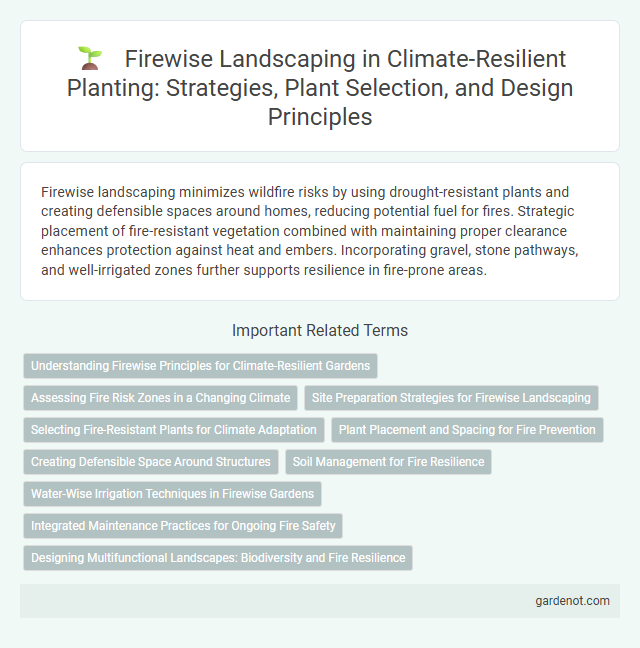Firewise landscaping minimizes wildfire risks by using drought-resistant plants and creating defensible spaces around homes, reducing potential fuel for fires. Strategic placement of fire-resistant vegetation combined with maintaining proper clearance enhances protection against heat and embers. Incorporating gravel, stone pathways, and well-irrigated zones further supports resilience in fire-prone areas.
Understanding Firewise Principles for Climate-Resilient Gardens
Firewise landscaping incorporates principles like selecting fire-resistant plants, maintaining proper spacing, and reducing combustible materials to create climate-resilient gardens. Emphasizing drought-tolerant species and strategic irrigation supports plant health during extended dry periods, mitigating wildfire risks. Proper mulching and regular maintenance further enhance garden resilience by minimizing fuel load and promoting moisture retention.
Assessing Fire Risk Zones in a Changing Climate
Firewise landscaping prioritizes assessing fire risk zones by analyzing vegetation density, topography, and historical fire data to create defensible spaces that reduce wildfire threats. Climate change intensifies fire frequency and severity, necessitating updated risk maps and adaptive planting strategies that choose fire-resistant species and maintain proper spacing. Effective evaluation integrates local climate projections, fuel moisture trends, and community engagement to design resilient landscapes that mitigate fire impact.
Site Preparation Strategies for Firewise Landscaping
Site preparation for Firewise landscaping emphasizes clearing flammable vegetation and debris within at least 30 feet of structures to create defensible space that reduces wildfire risk. Incorporating fire-resistant plants like succulents, native grasses, and hardwood trees enhances landscape resilience while minimizing fuel loads. Proper soil management and strategic placement of mulch and rock barriers further inhibit fire spread and improve plant health in fire-prone areas.
Selecting Fire-Resistant Plants for Climate Adaptation
Selecting fire-resistant plants is essential for climate-resilient planting in Firewise landscaping, as these species reduce wildfire risk by minimizing flammable vegetation around properties. Native plants such as manzanita, California lilac, and succulents offer high moisture content and low resin levels, making them less prone to ignition. Incorporating drought-tolerant, fire-resistant plants supports ecosystem adaptation to increasing temperatures and prolonged dry seasons caused by climate change.
Plant Placement and Spacing for Fire Prevention
Strategic plant placement and adequate spacing are critical components of Firewise landscaping aimed at reducing wildfire risks. Maintaining a minimum distance of 30 feet between shrubs and trees, along with incorporating fire-resistant plant species, creates defensible space that slows fire spread. Proper arrangement reduces the availability of continuous fuels, enhancing property protection and promoting landscape resilience in fire-prone areas.
Creating Defensible Space Around Structures
Creating defensible space around structures is essential in Firewise landscaping to reduce wildfire risk and protect property. This involves strategically placing fire-resistant plants, maintaining clear zones free of flammable materials, and ensuring adequate spacing between vegetation and buildings. Implementing these measures significantly enhances the resilience of landscapes to extreme fire events while safeguarding homes and communities.
Soil Management for Fire Resilience
Soil management plays a critical role in Firewise landscaping by enhancing moisture retention and reducing flammable vegetation growth. Techniques such as mulching with fire-resistant materials and improving soil organic matter increase the soil's ability to retain water, creating a natural barrier against wildfires. Proper soil aeration and nutrient balance promote healthy plant roots, which contribute to landscape resilience under drought and fire stress.
Water-Wise Irrigation Techniques in Firewise Gardens
Water-wise irrigation techniques in Firewise landscaping prioritize efficient water use to enhance plant health while reducing fire risk. Drip irrigation systems and soaker hoses deliver moisture directly to roots, minimizing evaporation and runoff, thus supporting drought-tolerant, fire-resistant plant species. Incorporating mulches and soil conditioners further conserves water and maintains optimal soil moisture for resilient garden ecosystems.
Integrated Maintenance Practices for Ongoing Fire Safety
Integrated maintenance practices for Firewise landscaping enhance long-term fire resilience by regularly clearing dead vegetation, pruning lower tree branches, and maintaining defensible space around structures. Consistent removal of flammable debris and managing plant density reduces fuel load, minimizing wildfire spread potential. Employing seasonal inspections and applying mulch carefully supports healthy soil moisture retention without increasing fire risk.
Designing Multifunctional Landscapes: Biodiversity and Fire Resilience
Designing multifunctional landscapes that integrate Firewise principles enhances both biodiversity and fire resilience by strategically selecting fire-resistant native plants that support local wildlife habitats. Incorporating a variety of plant species with different heights and moisture levels reduces fuel load while providing ecosystem services such as pollinator support and soil stabilization. Zoning landscapes into defensible spaces with buffer zones further mitigates wildfire risk and promotes ecological balance in climate-resilient planting strategies.
Firewise landscaping Infographic

 gardenot.com
gardenot.com